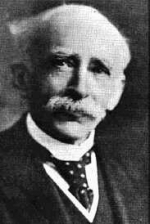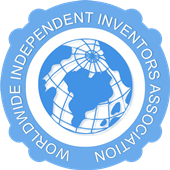- BY Admin
- POSTED IN Famous Inventors
- WITH 0 COMMENTS
- PERMALINK
- STANDARD POST TYPE

ir John Ambrose Fleming (November 29, 1849 – April 18, 1945) was an English electrical engineer and physicist. He is known for inventing the first thermionic valve or vacuum tube, the diode, then called the kenotron in 1904. He also invented the right hand rule, used in mathematics and electronics.He was born the eldest of seven children of James Fleming DD (d. 1879), a Congregational minister, and his wife, Mary Ann, at Lancaster, Lancashire and baptised on February 11, 1850. He was a devout Christian and preached on one occasion at St Martin-in-the-Fields in London on the topic of evidence for the resurrection. In 1932, along with Douglas Dewar and Bernard Acworth, he helped establish the Evolution Protest Movement. Having no children, he bequeathed much of his estate to Christian charities, especially those that helped the poor. He was an accomplished photographer and, in addition, he painted watercolours and enjoyed climbing in the Alps.
Early years
Ambrose Fleming was born in Lancaster and educated at University College School, London, and University College London. He became a Lecturer at several universities including the University of Cambridge, the University of Nottingham, and University College London, where he was the first professor of Electrical Engineering. He was also consultant to the Marconi Wireless Telegraph Company, Swan Company, Ferranti, Edison Telephone, and later the Edison Electric Light Company. In 1892, Fleming presented an important paper on electrical transformer theory to the Institution of Electrical Engineers in London.
Education and marriages
Fleming started school at about the age of ten, attending a private school where he particularly enjoyed geometry. Prior to that his mother tutored him and he had learned, virtually by heart, a book called the Child’s Guide to Knowledge, a popular book of the day – even as an adult he would quote from it. His schooling continued at the University College School where, although accomplished at maths, he habitually came bottom of the class at Latin.
Even as a boy he wanted to become an engineer. At 11 he had his own workshop where he built model boats and engines. He even built his own camera, the start of a lifelong interest in photography. Training to become an engineer was beyond the family’s financial resources, but he reached his goal via a path that alternated education with paid employment.
He enrolled for a BSc degree at University College, London, graduated in 1870, and studied under the mathematician Augustus de Morgan and the physicist George Carey Foster. He became a student of chemistry at the Royal College of Science in South Kensington in London (now Imperial College). There he first studied Alessandro Volta’s battery, which became the subject of his first scientific paper. This was the first paper to be read to the new Physical Society of London (now the Institute of Physics) and appears on page one of volume one of their Proceedings. Financial problems again forced him to work for a living and in the summer of 1874 he became science master at Cheltenham College, a public school, earning £400 per year. (He later also taught at Rossall School.) His own scientific research continued and he corresponded with James Clerk Maxwell at Cambridge University. After saving £400, and securing a grant of £50 a year, in October 1877 at the age of 27, he once again enrolled as a student, this time at Cambridge. Maxwell’s lectures, he admitted, were difficult to follow. Maxwell, he said, often appeared obscure and had “a paradoxical and allusive way of speaking”. On occasions Fleming was the only student at those lectures. Fleming again graduated, this time with a First Class Honours degree in chemistry and physics. He then obtained a DSc from London and served one year at Cambridge University as a demonstrator of mechanical engineering before being appointed as the first Professor of Physics and Mathematics at the University of Nottingham, but he left after less than a year.
On 11 June 1887 he married Clara Ripley (1856/7–1917), daughter of Walter Freake Pratt, a solicitor from Bath. On 27 July 1928 he married the popular young singer Olive May Franks (b. 1898/9), of Bristol, daughter of George Franks, a Cardiff businessman.
Activities and achievements
In November 1904, he invented and patented the two-electrode vacuum-tube rectifier, which he called the oscillation valve. It was also called a thermionic valve, vacuum diode, kenotron, thermionic tube, or Fleming valve. The Supreme Court of the United States later invalidated the patent because of an improper disclaimer and, additionally, maintained the technology in the patent was known art when filed. This invention is often considered to have been the beginning of electronics, for this was the first vacuum tube.[citation needed] Fleming’s diode was used in radio receivers and radars for many decades afterwards, until it was superseded by solid state electronic technology more than 50 years later.
In 1906, Lee De Forest of the U.S. added a control “grid” to the valve to create a vacuum tube RF detector called the Audion, leading Fleming to accuse him of copying his ideas. De Forest’s device was shortly refined by him and Edwin H. Armstrong into the first electronic amplifier, a tube called the triode. The triode was vital in the creation of long-distance telephone and radio communications, radars, and early electronic digital computers (mechanical and electro-mechanical digital computers already existed using different technology). Fleming also contributed in the fields of photometry, electronics, wireless telegraphy (radio), and electrical measurements. He was knighted in 1929, and died at his home in Sidmouth, Devon in 1945. His contributions to electronic communications and radar were of vital importance in winning World War II. Fleming was awarded the IRE Medal of Honor in 1933 for “the conspicuous part he played in introducing physical and engineering principles into the radio art”.
Note from eulogy at the Centenary celebration of the invention of the thermionic valve:
One century ago, in November 1904, John Ambrose Fleming FRS, Pender Professor at UCL, filed GB patent 190424850 in Great Britain, for a device called the Thermionic Valve. When inserted together with a galvanometer, into a tuned electrical circuit, it could be used as a very sensitive rectifying detector of high frequency wireless currents, known as radio waves. It was a major step forward in the ‘wireless revolution’.
In November 1905, he patented the “Fleming Valve” (US patent 803684 ). As a rectifying diode, and forerunner to the triode valve and many related structures, it can also be considered to be the device that gave birth to modern electronics. In the ensuing years such valves, were largely superseded by “cat’s whiskers”, and decades later most electron tubes, as they became generically known, were gradually replaced by semiconductor diodes and transistors, which were significantly smaller, cheaper, and more reliable. In time and in turn, even these have been largely replaced by integrated circuits, better known as silicon chips. Today, descendants of the original vacuum tube still play an important role in a range of applications. They can be found in the power stages of radio and television transmitters, in audio amplifiers, as detectors of optical and short wavelength radiation, and in sensitive equipment that must be “radiation-hard”. On the 27th November 2004 a Blue Plaque (presented by the Institue of Physics) was unveiled at the “Norman Lockyer Observatory”, Sidmouth, to mark 100 years since the invention of the Thermionic Radio Valve.
Books by Fleming
Electric Lamps and Electric Lighting: A course of four lectures on electric illumination delivered at the Royal Institution of Great Britain (1894) 228 pages, ISBN 0548479377.
Waves and Ripples in Water, Air, and Aether MacMillan (1902).
The Principles of Electric Wave Telegraphy (1906), Longmans Green, London, 671 pages.
The Propagation of Electric Currents in Telephone and Telegraph Conductors (1911) Constable, 316 pages.
The Thermionic Valve and its Development in Radio Telegraphy and Telephony (1919).
An Elementary Manual of Radiotelegraphy and Radiotelephony (1911) Longmans Green, London, 340 pages.
On the power factor and conductivity of dielectrics when tested with alternating electric currents of telephonic frequency at various temperatures (1912) Gresham, 82 pages, ASIN: B0008CJBIC
Evolution or Creation? (1938) Marshall Morgan and Scott, 114 pages, ASIN: B00089BL7Y – outlines objections to Darwin.
References
^ Harr, Chris (2003-06-23). Ambrose J. Fleming biography. Pioneers of Computing. The History of Computing Project. Retrieved on 2008-04-30.
^ Right and left hand rules. Tutorials, Magnet Lab U.. National High Magnetic Field Laboratory. Retrieved on 2008-04-30.
^ “Misreading the Supreme Court: A Puzzling Chapter in the History of Radio”. November 1998, Mercurians.org.
Brittain James E. (2007). “John A. Fleming”. Proceedings of the IEEE 95 (1): 313-315.
External articles
IEEE History Center biography
Department of Electronic & Electrical Engineering, UCL – home of the original Fleming valve




